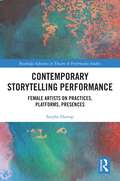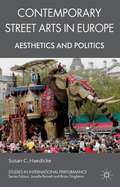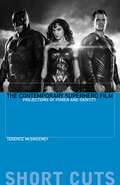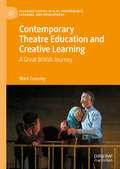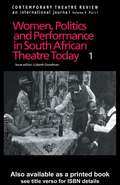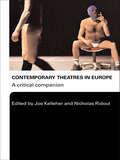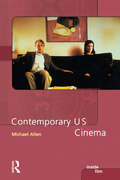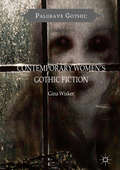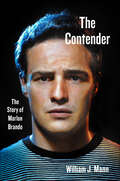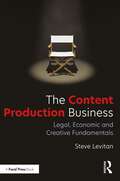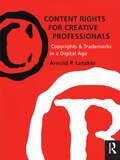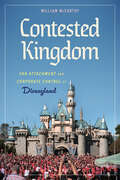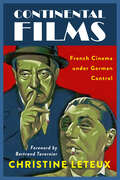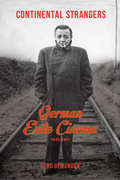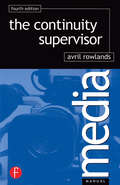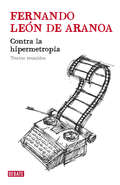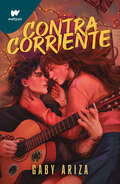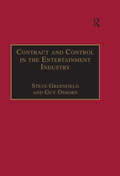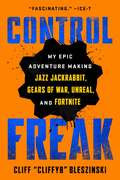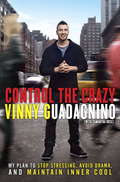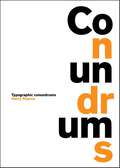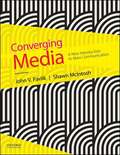- Table View
- List View
Contemporary Storytelling Performance: Female Artists on Practices, Platforms, Presences (Routledge Advances in Theatre & Performance Studies)
by Stephe HarropThis book focuses on a rising generation of female storytellers, analysing their innovation in interdisciplinary collaboration, and their creation of new multimedia platforms for story-led performance. It draws on an unprecedented series of in-depth interviews with artists including Jo Blake, Xanthe Gresham-Knight, Mara Menzies, Clare Murphy, Debs Newbold, Rachel Rose Reid, Sarah Liisa Wilkinson, and Vanessa Woolf, while Sally Pomme Clayton’s reflections on her extraordinary four-decade career provide long-term context for these cutting-edge conversations. Blending ethnographic research and performance analysis, the book documents the working lives of professional storytelling artists. It sheds light on the practices, values, aspirations, and achievements of a generation actively re-defining storytelling as a contemporary performance practice, taking on topics from ecology and maternity to griefwork and neuroscience, while working collaboratively with diverse creative partners to generate new, inclusive presences for a traditionally-inspired artform. This book will be of great interest to students, scholars, and practitioners in drama, theatre, performance, creative writing, education, and media.
Contemporary Street Arts in Europe
by Susan C. HaedickeStreet theatre invades a public space, shakes it up and disappears, but the memory of the disruption haunts the site for audiences who experience it. This book looks at how the dynamic interrelationship of performance, participant and place creates a politicized aesthetic of public space that enables the public to rehearse democratic practices.
The Contemporary Superhero Film: Projections of Power and Identity (Short Cuts)
by Terence McSweeneyAudiences around the globe continue to flock to see the latest releases from Marvel and DC studios, making it clear that superhero films resonate with the largest global audience that Hollywood has ever reached. Yet despite dominating theater screens like never before, the superhero genre remains critically marginalized—ignored at best and more often actively maligned.Terence McSweeney examines this global phenomenon, providing a concise and up-to-date overview of the superhero genre. He lays out its narrative codes and conventions, exploring why it appeals to diverse audiences and what it has to say about the world in the first two decades of the twenty-first century. Unpacking the social, ideological, and cultural content of superhero films, he argues that the genre should be considered a barometer of contemporary social anxieties and a reflection of cultural values. McSweeney scrutinizes representations of gender, race, and sexuality as well as how the genre’s conventions relate to and comment on contemporary political debates. Beyond American contributions to the genre, the book also features extensive analysis of superhero films from all over the world, contrasting them with the dominant U.S. model.The book’s presentation of a range of case studies and critical debates is accessible and engaging for students, scholars, and enthusiasts at all levels.
Contemporary Theatre Education and Creative Learning: A Great British Journey (Palgrave Studies In Play, Performance, Learning, and Development)
by Mark CrossleyThis book considers the state of contemporary theatre education in Great Britain is in two parts. The first half considers the national identities of each of the three mainland nations of England, Scotland, and Wales to understand how these differing identities are reflected and refracted through culture, theatre education and creative learning. The second half attends to 21st century theatre education, proposing a more explicit correlation between contemporary theatre and theatre education. It considers how theatre education in the country has arrived at its current state and why it is often marginalised in national discourse. Attention is given to some of the most significant developments in contemporary theatre education across the three nations, reflecting on how such practice is informed by and offers a challenge to conceptions of place and nation. Drawing upon the latest research and strategic thinking in culture and the arts, and providing over thirty interviews and practitioner case studies, this book is infused with a rigorous and detailed analysis of theatre education, and illuminated by the voices and perspectives of innovative theatre practitioners.
Contemporary Theatre Review: Women, Politics and Performance in South African Theatre Today (Contemporary Theatre Review Ser. #Vols. 9, Pts. 1.)
by Lizbeth GoodmanFirst published in 1999, 'Women, Politics and Performance in South African Theatre Today' is an important contribution to Performance.
Contemporary Theatres in Europe: A Critical Companion
by Joe Kelleher Nicholas RidoutThrough specific examples, case studies and essays by specialist writers, academics, and a new generation of theatre researchers, this collection of specially commissioned essays looks at current theatre practices across Europe. From Théatre du Soleil to Socìetas Raffaello Sanzio, the authors reconsider the possibilities of theatre practice, its relation to history and location and its place in Europe at the turn of the twenty-first century. Contemporary Theatres in Europe examines a wide range of topics including: mainstream European theatre experimental performance music theatre theatre for children dance theatre. Tailor-made for students, offering clear examples of different ways of thinking and writing about performance, this is a richly detailed introduction which brings key themes to life for all students of European theatre.
Contemporary US Cinema (Inside Film)
by Michael AllenContemporary U.S. Cinema is a forceful exploration of the tumultuous changes that have dominated the shifting landscape of American film-making over the past three decades. From the explosive release of Easy Rider to the excesses of Heaven's Gate and the comic book figures of Spider-Man, its aim is to examine the economic, social and cultural contexts of mainstream and independent American films. The book divides into nine provocative chapters with material on: the most significant individual film-makers, such as Scorsese, Coppola and Lucas, as well as independent film-makers like Jarmusch and Anders the careers of leading actors of the last thirty years, such as Jack Nicholson, Robert Redford and Julia Roberts, whilst exploring the powerful position of the film star in the modern American film-making process the economics of Contemporary U.S. Cinema with particular reference to the tortuous journey from production, distribution and exhibition of Waterworld and Titanic the artistic influence of foreign film-makers, such as François Truffaut and Jean-Luc Godard, and explores Hollywood's increasing dominance and reliance on the global market genres, sequels and the recent developments in computer-based technologies, using examples from The Godfather I - III, The Matrix, the Star Wars saga and remakes from Shaft to Ocean's Eleven The book is illustrated with stills throughout and includes a bibliography and annotated further reading list.
Contemporary Women's Gothic Fiction: Carnival, Hauntings and Vampire Kisses (Palgrave Gothic)
by Gina WiskerThis book revives and revitalises the literary Gothic in the hands of contemporary women writers. It makes a scholarly, lively and convincing case that the Gothic makes horror respectable, and establishes contemporary women’s Gothic fictions in and against traditional Gothic. The book provides new, engaging perspectives on established contemporary women Gothic writers, with a particular focus on Angela Carter, Margaret Atwood and Toni Morrison. It explores how the Gothic is malleable in their hands and is used to demythologise oppressions based on difference in gender and ethnicity. The study presents new Gothic work and new nuances, critiques of dangerous complacency and radical questionings of what is safe and conformist in works as diverse as Twilight (Stephenie Meyer) and A Girl Walks Home Alone (Ana Lily Amirpur), as well as by Anne Rice and Poppy Brite. It also introduces and critically explores postcolonial, vampire and neohistorical Gothic and women’s ghost stories.
The Contender: The Story of Marlon Brando
by William J. MannEntertainment Weekly's BIG FALL BOOKS PREVIEW SelectionBest Book of 2019 -- Publisher's WeeklyBased on new and revelatory material from Brando’s own private archives, an award-winning film biographer presents a deeply-textured, ambitious, and definitive portrait of the greatest movie actor of the twentieth century, the elusive Marlon Brando, bringing his extraordinarily complex life into view as never before.The most influential movie actor of his era, Marlon Brando changed the way other actors perceived their craft. His approach was natural, honest, and deeply personal, resulting in performances—most notably in A Streetcar Named Desire and On the Waterfront—that are without parallel. Brando was heralded as the American Hamlet—the Yank who surpassed British stage royalty Laurence Olivier, John Gielgud, and Ralph Richardson as the standard of greatness in the mid-twentieth century. Brando’s impact on American culture matches his professional significance; he both challenged and codified our ideas of masculinity and sexuality. Brando was also one of the first stars to use his fame as a platform to address social, political, and moral issues, courageously calling out America’s deeply rooted racism.William Mann’s brilliant biography of the Hollywood legend illuminates this culture icon for a new age. Mann astutely argues that Brando was not only a great actor but also a cultural soothsayer, a Cassandra warning us about the challenges to come. Brando’s admonitions against the monetization of nearly every aspect of the culture were prescient. His public protests against racial segregation and discrimination at the height of the Civil Rights movement—getting himself arrested at least once—were criticized as being needlessly provocative. Yet those actions of fifty years ago have become a model many actors follow today.Psychologically astute and masterfully researched, based on new and revelatory material, The Contender explores the star and the man in full, including the childhood traumas that reverberated through his professional and personal life. It is a dazzling biography of our nation’s greatest actor that is sure to become an instant classic.The Contender includes sixteen pages of photographs.
The Content Production Business: Legal, Economic and Creative Basics for Producers
by Steve LevitanThis book goes beyond the technical steps in the process of making film, TV, and media material, examining what it means to be an ongoing supplier of content to the marketplace and how to become one. Steve Levitan brings insights and experience from his lifelong career producing in the content industry, where he has also acted as a professional advisor to content makers, distributors and providers, whilst setting up his own production company. Producing as a Business offers strategic, tactical, financial, legal and marketing insights for the successful establishment of content creation enterprises. Readers will gain insight into how to avoid starting from square one with each project, while also learning how to maintain a meaningful level of ownership and build a revenue stream that can sustain a core operation, helping establish them as a “player” in the industry. This text is aimed at the international production industry, with real examples referred to throughout. Film, television, and media production students who are looking to understandthe business of producing, as well as first-time producers who are already familiar with the basics of the production process, will benefit from an examination of the building blocks that form lasting production companies.
Content Rights for Creative Professionals: Copyrights & Trademarks in a Digital Age
by Arnold P. LutzkerContent Rights for Creative Professionals is for professionals and students working in all areas of media (film/video, photography, multimedia, web, graphics, and broadcast) who need to know what the law requires and how they should properly utilize copyrights and trademarks. This book outlines critical concepts and applies them with explanations in real-life applications, including many cases from the author's own practice as well as those of various media professionals. This 256 page text is a practical guide designed to provide its reader with a firm understanding of the principles underlying the ownership and use of content, so that when questions arise, they will be able to make correct, well-informed decisions-whether concerning their personal works, or works of others that a company wishes to copyright or trademark. In addition, the reader will be more capable of exercising sound judgment in structuring employment and contract relationships and of acquiring and/or licensing works, which are at the core of the business of communicating.
Contested Kingdom: Fan Attachment and Corporate Control at Disneyland
by William McCarthyIn Contested Kingdom: Fan Attachment and Corporate Control at Disneyland, William McCarthy presents a groundbreaking study centered on the history of Disneyland and Disney theme park enthusiasts. Focusing on two unexplored yet interconnected phenomena—the dynamic relationship between the Disney corporation and Southern Californian fans in both online and physical park settings over a span of more than three decades—this volume sheds new light on the meaning and purpose of Disneyland. Through a comprehensive analysis of the interwoven dimensions of individuals, place, and cognitive, affective, and behavioral processes, McCarthy explores the fervent sense of place attachment experienced by the approximately one million annual passholders who visit the park. McCarthy’s analysis extends beyond the physical world of Disneyland by delving into the evolution of Disney fandom, discourse, commerce, and social formations in online social platforms like Usenet, web discussion boards, and social media. By employing a mixed-methods approach incorporating interviews, participant observation, surveys, and data analysis, this study establishes a novel analytical framework for comprehending the interrelationships between the Disney corporation, its fan communities, and online social platforms. As the first in-depth longitudinal analysis of the ongoing struggle on successive social platforms between fan users and a corporate entity, Contested Kingdom provides valuable insights for scholars and future investigations.
Continental Films: French Cinema under German Control (Wisconsin Film Studies)
by Christine LeteuxFrom 1940 to 1944, the German-owned Continental Films dominated the French film landscape, producing thirty features throughout the Nazi occupation. Charged with producing entertaining and profitable films rather than propaganda, producer Alfred Greven employed some of the greatest French actors and most prestigious directors of the time, including Maurice Tourneur, Henri Decoin, Henri-Georges Clouzot, and Marcel Carné. Using recently opened archival documents, including reams of testimony from the épuration (purification) hearings conducted shortly after the war, Christine Leteux has produced the most authoritative and complete history of the company and its impact on the French film industry—both during the war and after. She captures the wide range of responses to the firm from those who were eager to work for a company whose ideology matched their own, to others who reluctantly accepted contracts out of necessity, to those who abhorred the company but felt compelled to participate in order to protect family members from Nazi reprisals. She examines not only the formation and management of Continental Films but also the personalities involved, the fraught and often deadly political circumstances of the period, the critical reception of the films, and many of the more notorious and controversial events. As Bertrand Tavernier explains in his foreword, Leteux overturns many of the preconceptions and clichés that have come to be associated with Continental Films. Published to rave reviews in French and translated by the author into English, this work shatters expectations and will reinvigorate study of a lesser-known but significant period of French film history.
Continental Strangers: German Exile Cinema, 1933-1951 (Film and Culture Series)
by Gerd GemündenHundreds of German-speaking film professionals took refuge in Hollywood during the 1930s and 1940s, making a lasting contribution to American cinema. Hailing from Austria, Hungary, Poland, Russia, and the Ukraine, as well as Germany, and including Ernst Lubitsch, Fred Zinnemann, Billy Wilder, and Fritz Lang, these multicultural, multilingual writers and directors betrayed distinct cultural sensibilities in their art. Gerd Gemünden focuses on Edgar G. Ulmer's The Black Cat (1934), William Dieterle's The Life of Emile Zola (1937), Ernst Lubitsch's To Be or Not to Be (1942), Bertolt Brecht and Fritz Lang's Hangmen Also Die (1943), Fred Zinnemann's Act of Violence (1948), and Peter Lorre's Der Verlorene (1951), engaging with issues of realism, auteurism, and genre while tracing the relationship between film and history, Hollywood politics and censorship, and exile and (re)migration.
Continental Strangers: German Exile Cinema, 1933-1951
by Gerd GemündenHundreds of German-speaking film professionals took refuge in Hollywood during the 1930s and 1940s, making a lasting contribution to American cinema. Hailing from Austria, Hungary, Poland, Russia, and the Ukraine, as well as Germany, and including Ernst Lubitsch, Fred Zinnemann, Billy Wilder, and Fritz Lang, these multicultural, multilingual writers and directors betrayed distinct cultural sensibilities in their art. Gerd Gemünden focuses on Edgar G. Ulmer's The Black Cat (1934), William Dieterle's The Life of Emile Zola (1937), Ernst Lubitsch's To Be or Not to Be (1942), Bertolt Brecht and Fritz Lang's Hangmen Also Die (1943), Fred Zinnemann's Act of Violence (1948), and Peter Lorre's Der Verlorene (1951), engaging with issues of realism, auteurism, and genre while tracing the relationship between film and history, Hollywood politics and censorship, and exile and (re)migration.
Continuity Supervisor
by Avril RowlandsThe Continuity Supervisor is a practical guide to the basics of continuity, designed to be of use both to the newcomer and those more experienced. Formerly titled 'The Continuity Handbook: a guide for single-camera shooting, this new edition covers the latest technological changes which affect the Continuity Supervisor. Avril Rowlands worked at the BBC for any years as a PA. She has been involved in specialised training for the television industry and major film and television colleges. Her highly acclaimed residential courses attract students from major television companies worldwide. She is also a writer and independent television producer.
Contra la hipermetropía: Textos reunidos
by Fernando LeónAntología de los mejores textos de Fernando León Fernando León de Aranoa ha protagonizado una de las trayectorias más exitosas del reciente cine español. Su mirada personal y el trazo humano que caracteriza sus películas han conectado con un amplio público que se identifica con el cine que huye de los grandes escenarios y se declara resueltamente en contra de la hipermetropía. En este libro se recogen textos vinculados directamente con las películas de Fernando León, escritos de muy diversa índole, de su visión del oficio de cineasta, de sus películas favoritas, de temas que le han interesado, y una escueta selección de relatos breves. Pero todos reflejan su peculiar mirada y la impronta de su singular pincelada, y ayudan a desentrañar las claves de uno de los directores más interesantes del cine español.
Contracorriente
by Gaby ArizaUn amor único e inolvidable, una cuenta regresiva y un destino que desafía todas las probabilidades. Maju debe dejar atrás todo lo que conoce y viajar a otro país para terminar sus estudios. Al llegar a su nuevo hogar se encuentra con una ciudad llena de vida, amigos nuevos y... el enigmático cantante y guitarrista de la banda Indie Gentes, que además es su compañero de curso. Santi es distante y reservado. No parece encajar en ningún lado. La música es su único refugio. Pero la conexión con Maju es instantánea y entre ellos nace un amor apasionado que empieza a desarmar los muros que lo protegían. Solo hay un problema: Maju tiene planeado continuar su viaje cuando termine el colegio y Santi va a quedarse en su ciudad para intentar triunfar con la música. ¿Serán capaces de amar a contracorriente? Los lectores dicen:«Esta historia es ese lugar feliz al que me gusta volver una y otra vez. Santi y Maju tienen un lugar muy especial en mi corazón». «La amé, sentí todos y cada uno de los momentos como si fuesen míos». «Maravillosamente real».«Este libro me hizo sentir que pertenezco a algún lugar». «Es uno de los libros más lindos que he leído, lo amo».
Contract and Control in the Entertainment Industry: Dancing on the Edge of Heaven (Studies in Modern Law and Policy)
by Steve Greenfield Guy OsbornThis book examines the contractual relationships of creative artists within a number of areas of the entertainment industry. Whilst it focuses specifically on football, cricket, boxing and music, developments within other parts of the entertainment business are observed. The book also charts the concessions (artistic, professional and personal) that are often made by such artists in an attempt to achieve success and the consequent legal problems that may arise from their working relationships. Embracing historical materials and current legal practices, Contract and Control in the Entertainment Industry will be of interest to academics and students in the fields of law, sociology and cultural studies. It will also appeal to anyone who is interested in seeing how many areas of the entertainment industry have placed very restrictive contractual controls on the raw materials of the industry - the creative artists.
Control Freak: My Epic Adventure Making Video Games
by Cliff BleszinskiThe designer of Unreal and Gears of War offers an eye-opening personal account of the video game industry as it grew from niche hobby to hundred-billion-dollar enterprise.Video games are dominating the planet. In 2020, they brought in $180 billion dollars globally—nearly $34 billion in the United States alone. So who are the brilliant designers who create these stunning virtual worlds? Cliff Bleszinski—or CliffyB as he is known to gamers—is one of the few who&’ve reached mythical, rock star status. In Control Freak, he gives an unvarnished, all-access tour of the business. Toiling away in his bedroom, Bleszinski created and shipped his first game before graduating high school, and at just seventeen joined a fledgling company called Epic Games. He describes the grueling hours, obscene amounts of Mountain Dew and obsessive focus necessary to achieve his singular creative visions. He details Epic&’s rise to industry leader, thanks largely to his work on bestselling franchises Unreal and Gears of War (and, later, his input on a little game called Fortnite), as well as his own awkward ascent from shy, acne-riddled introvert to sports car-driving celebrity rubbing shoulders with Bill Gates. As he writes, &“No one is weirder than a nerd with money.&” While the book is laced with such self-deprecating humor, Bleszinski also bluntly addresses the challenges that have long-faced the gaming community, including sexism and a lack of representation among both designers and the characters they create. Control Freak is a hilarious, thoughtful, and inspiring memoir. Even if you don&’t play games, you&’ll walk away from this book recognizing them as a true art form and appreciating the genius of their creators.
Control the Crazy
by Vinny Guadagnino Samantha RoseWe all have the power to make our lives better in an instant. You have absolute power to control your crazy. In his new book, Vinny from Jersey Shore shares the step-by-step program that has helped him get a handle on his anxious mind and filled him with a sense of personal power and control that has rocked every facet of his life.
Conundrums: Typographic Conundrums
by Harry PearceConundrum is a mind-stretch. Encrypting idioms into their typographic equivalents, Harry enlivens our everyday language and challenges readers to see that "time after time after time" or, at least, "more often than not" "the writing is on the wall." For fans of word puzzles, sudoku, crosswords, and all manner of mind games, Conundrum offers an artfully packaged, cleverly designed new challenge. Drawing upon, literally in this case, graphic puzzles that he began creating as a child, Harry's developed over 100 witty conundrums for this book that will stretch the mind as well as delight the senses. A member of the Alliance Graphique Internationale, a frequent lecturer and contributor to design discourse, an internationally recognized leader in design, and a founder of Lippa Pearce, one of the UK's most respected design agencies, Harry refines the way we see and communicate. Conundrum achieves nothing less than changing how we understand and interact with language.
Converging Media
by John V. Pavlik Shawn McIntoshIndustry. Culture. Technology. It's time they came together. From reading news on tablets to video calling on smartphones, digital media has changed the ways in which we communicate. Placing convergence at the center of the discussion, Converging Media: A New Introduction to Mass Communication, Sixth Edition, uses the technologies we employ every day to explain our current media environment--and to consider where we might be headed.
A Conversation on Music
by Anton RubensteinRuminations on Bach, Mozart, Chopin, Glinka, Berlioz, Liszt, Schumann, Wagner and other classical composers
The Conversations: Walter Murch and the Art of the Editing Film
by Michael OndaatjeThe Conversationsis a treasure, essential for any lover or student of film, and a rare, intimate glimpse into the worlds of two accomplished artists who share a great passion for film and storytelling, and whose knowledge and love of the crafts of writing and film shine through. It was on the set of the movie adaptation of his Booker Prize-winning novel, The English Patient, that Michael Ondaatje met the master film and sound editor Walter Murch, and the two began a remarkable personal conversation about the making of films and books in our time that continued over two years. From those conversations stemmed this enlightened, affectionate book -- a mine of wonderful, surprising observations and information about editing, writing and literature, music and sound, the I-Ching, dreams, art and history. The Conversationsis filled with stories about how some of the most important movies of the last thirty years were made and about the people who brought them to the screen. It traces the artistic growth of Murch, as well as his friends and contemporaries -- including directors such as Francis Ford Coppola, George Lucas, Fred Zinneman and Anthony Minghella -- from the creation of the independent, anti-Hollywood Zoetrope by a handful of brilliant, bearded young men to the recent triumph of Apocalypse Now Redux. Among the films Murch has worked on are American Graffiti, The Conversation, the remake of A Touch of Evil, Julia, Apocalypse Now, The Godfather(all three), The Talented Mr. Ripley, and The English Patient. “Walter Murch is a true oddity in Hollywood. A genuine intellectual and renaissance man who appears wise and private at the centre of various temporary storms to do with film making and his whole generation of filmmakers. He knows, probably, where a lot of the bodies are buried. ”
